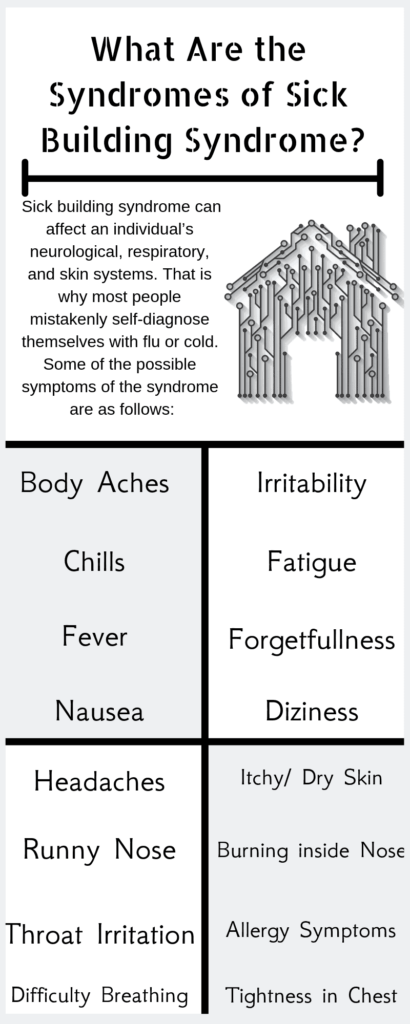What is Sick Building Syndrome?
Sick building syndrome is also known as building-related illness, environmental illness, or multiple chemical sensitivity. Clinicians consider it to be an illness that people suffer from when they are exposed to undefined physical, biological, or chemical agents that are located in a building.
This term was first used in the year 1986 when the illness was recognized. However, the term is used a lot more in medical literature nowadays. It is mostly attributed to indoor air quality that is poor. Its diagnosis is challenging because of the wide variety of symptoms that mimic other medical conditions.
 What Are the Syndromes of Sick Building Syndrome?
What Are the Syndromes of Sick Building Syndrome?
Sick building syndrome can affect an individual’s neurological, respiratory, and skin systems. That is why most people mistakenly self-diagnose themselves with flu or cold. Some of the possible symptoms of the syndrome are as follows:
-Chills
-Fever
-Body aches
-Nausea
-Irritability
-Fatigue
-Forgetfulness
-Difficulty concentrating
-Dizziness
-Headaches
-Itchy and dry skin rashes
-Burning sensations inside the nose
-Allergy-like symptoms i.e. sneezing
-Runny nose
-Tightness inside the chest
-Breathing difficulties
-Throat irritation
It is important to note that Sick Building Syndrome affects every individual differently. This means that some people might even fail to experience any of the above symptoms. On the other hand, some people might even experience these symptoms after leaving a building.
What Causes Sick Building Syndrome?
Usually, the term Sick Building Syndrome is used in cases where symptoms cannot be accurately identified. The following are some possible causes:
-Animal or insect droppings
-Noisy work environments
-Low humidity or heat
-Low workplace morale
-High stress levels at school or work
-Ozone from use of fax machines or printers
-Carbon monoxide pollution
-Pesticides
-Chemicals present in the air that come from cleaning products
-Asbestos
-Formaldehyde that is commonly found in wood floors and furniture
-Presence of fungus or mold
-Computer displays that are outdated thus leading to eye strain
-Rooms that have poor lighting
-Tobacco smoke
-Very high levels of dust
-Buildings that have poor ventilation like public spaces, offices, and schools
How Do Doctors Diagnose Sick Building Syndrome?
The process of diagnosing the Sick Building Syndrome is one of elimination. Doctors start by ruling out conditions that might mimic it such as allergies, asthma, or cold. Doctors will also ask about the kind of environment you have at home and at work.
Patients should also consider keeping accurate journals where symptoms are recorded. This means that they record where and when the symptoms start and when they stop. The secret lies in being very specific about the symptoms.
What is the Treatment for Sick Building Syndrome?
The primary treatment technique of sick building syndrome is decreasing the exposure to causative factors and agents of the symptoms. There are allergy medications that can be used to alleviate itchy skin, nose, and eyes. Over-the-counter medications are also available. Asthma medications might be used for wheezing and other breathing difficulties. One helpful solution can be an air filter, such as an EnviroKlenz product that helps in eliminating odors and toxins .
Employers can also take certain steps to treat the syndrome:
- Changing lights as required
- Vacuuming regularly to eliminate dust
- Testing for indoor fungus or mold
- Changing air filters regularly
- Using cleaning products with no fragrances and low fumes

Conclusion
It is very possible to prevent Sick Building Syndrome once you are aware of its causes. Employees can take various preventive measures that can go a long way in making them look and feel good while at work.
Comments
Post a Comment